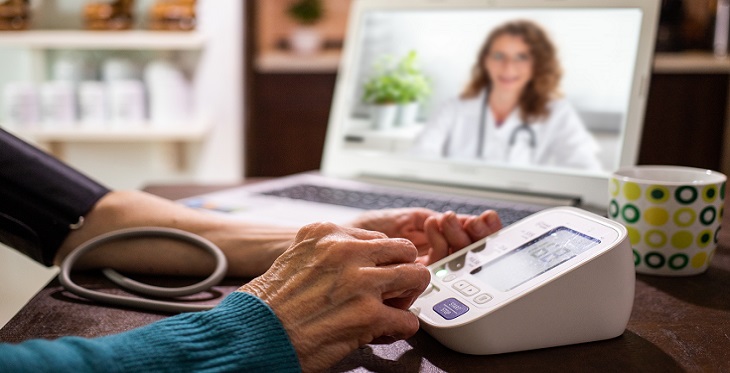Interacting with patients while they are in their familiar home surroundings is much more common today than it was 2 years ago. In fact, 70% of patients have the option for a telehealth visit as a criterion for selecting a primary care provider. The most common home telehealth encounter is done using videoconferencing technology. Most commonly, the provider (or their staff) who has scheduled the meeting emails a link to the electronic meeting platform to the patient. A tablet, smartphone, laptop or desktop computer can be used, but only if it has a camera. In the true sense of the word, the encounter is often a meeting and not an assessment. However, in general, the purpose of the encounter is to assess the condition of the patient. There is a greater emphasis on using the visual capabilities of the camera and the skills of the provider to transform the meeting to into an assessment as necessary.
So, what is patient-centered care? Healthcare providers have espoused the importance of patient-centered care for years. Patients value providers that consider their unique goals and situations. However, assessing a patient during a clinic visit is challenging without contextual knowledge about their lifestyles. Understanding patient-centered needs involves relying on answers to questions that hope to target risks, concerns or barriers to potential interventions. Due to the challenges associated with the limited time for patient interaction, patient-centered care is often reserved for the outspoken, medically savvy patient, not for generations or cultures or individuals that are more reticent. The current burgeoning use of telehealth provides an opportunity to move closer to a true patient-centered model. This new model takes advantage of the telehealth “window” that provides a view of contextual lifestyle knowledge. For example, a diabetic patient can show their provider the types of food they have in their kitchen simply but pointing the camera at their fridge. It is an opportunity to use telehealth to improve care and not merely attempt to reproduce our current model of care.
The use of telehealth technology clearly changes the techniques involved in an assessment. Crisis-based use of telehealth (i.e., COVID) was the result of the need to provide an immediate substitute for the in-person patient clinic visit. In reality, telehealth enables an assessment that is more akin to home–based medical care. The provider is a guest and out of their environment in contrast to the patient being the guest in the clinic. Patients now have a greater sense of control. The greatest change in technique is the provision of an assessment without being able to touch the patient. This requires augmentation of visual assessment skills and more attention to the types of questions required to obtain information from the patient about their health concerns.
Detection of visual clues that indicate risk factors or barriers to effective interventions require the time and ability to use a camera as the provider’s eye. Using the smartphone, tablet or even laptop as a proxy for a home-based medical care provider’s eye to observe the patient in their home is quite different from current fixed videoconferencing. Aside from learning to be more observant, time and concerns for invasion of privacy are potential barriers. A framework for viewing areas helps prompt providers.
To help with this, we developed the Comprehensive Patient Assessment using Telehealth in the Home (CPATH) framework.1 It’s a basic framework with reminders of primary areas (domains) that enables health care providers to obtain intentional and consistent assessment information. Using a quantitative content validity method, experts determined five key CPATH domains. The domains are patient characteristics (physical and psychological), environment, medical equipment, medications, and caregiver interests. Each patient has a unique combination of diagnoses, risks and lifestyles, so the CPATH domains are intentionally broad. Use of the CPATH allows for individualization within each domain.
After determining the domains of the CPATH, we conducted a pilot study that provided patient and caregivers perspectives of a telehealth visit by an Advanced Practice Nurse Practitioner (APRN) guided by CPATH. Patients found that moving the cameras was not difficult unless they were disabled. Caregivers had no difficulty. The participants also described telehealth assessments on a continuum ranging from “telehealth preferred” to “telehealth not acceptable” 2, and felt that a combination of in-person and telehealth visits was ideal. All participants agreed that privacy was not a concern. In fact, APRNs later commented that participants wanted to continue using the CPATH domains for telehealth after the study was completed! Due to our prior findings that a shared understanding of the intent of the remote visit is needed 3, this was a high priority in the pilot study. Introductions that included intended actions and the purpose of the visit prior to implementing the CPATH domains were part of the protocol. Surprisingly a theme that emerged in the qualitative analysis was improvement by making sure that the reason for the telehealth meeting be stated at the beginning of the encounter. More research is needed to determine why this gap continues to exist.
Preliminary results demonstrate that the patient characteristics domain takes the most time with, on the average, four times as many minutes as the other domains. The average visit lasted 20 minutes, including small talk and introductions. Satisfaction was high. Several new causes for concern were detected using the CPATH. One example is that kinesiology tape was seen on the table in the house of one patient. When queried, the participant reported that he was taping his ankles because they were swelling. If the provider had not seen the tape and asked about it, the swelling may never have been raised by the patient. Another example was discoloration of tubing for a CPAP machine, potentially indicating fungi. In many visits, several medications questions arose when asking to view how medications were stored. Several skin rashes were observed, and of course the usual throw rugs caused concern for falls.
Telehealth’s great value is at the forefront of health care. Now is the time to use techniques that capitalize on its ability to improve care. Consideration of lifestyles enables individualized interventions. Using the CPATH framework as a guide supports patient-centered care without providers having to ask leading questions that “guess” at the answer. Intentional assessment occurs when using the CPATH, however, observation techniques and skills are critical. The CPATH domains provide a framework to guide health care providers to be inclusive of individual patient characteristics, environment, medications, medical equipment and the attentiveness of a family caregiver. Our study demonstrated that patients value telehealth and are not concerned about privacy issues when a provider is virtually looking around their home. Moving the camera to display the CPATH domains is feasible for patients and risk factors for complications are detectable by providers. CPATH demonstrates that telehealth with intentional camera movement is useful for assessment of previously diagnosed conditions, leads to individualized interventions, can reduce risk and prevent complications.
1. Shea KD, Towers V, Koon M, Silva G. Development of an Intentional Telehealth Viewing Guide for Home-Based Patient Assessment. Telemedicine Reports 2021;2:32-8.
2. Bethel CMSNRNBC, Towers VMSNFNPBC, Crist JDPRNFF, Silva GEPMPH, Shea KPRNF. A Guide for Intentional Home Telehealth Assessment: Patient and Caregiver Perceptions. CIN: Computers, Informatics, Nursing.
3. Shea K, Chamoff B. Telehomecare Communication and Self-Care in Chronic Conditions: Moving Toward a Shared Understanding. Worldviews on Evidence-Based Nursing 2012;9:109-16.

